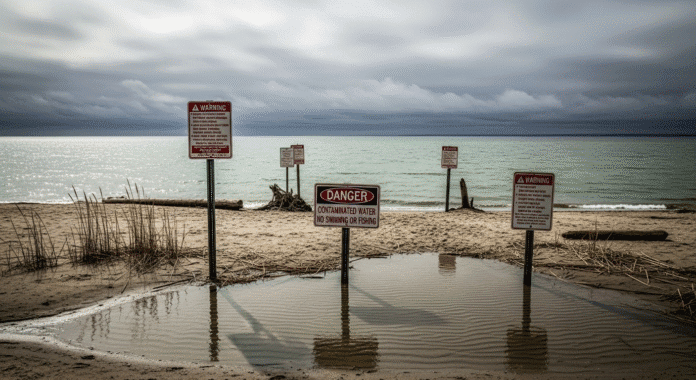A Summer Crisis on the Shores of Oneida Lake
On an otherwise vibrant summer day along Oneida Lake, a startling change has gripped Sylvan Beach. What was once a bustling hub of swimmers and boats now wears an eerie silence. The culprit is a severe harmful algal bloom—the worst seen in over a decade—casting a shadow over local health, the economy, and the natural splendor so cherished by residents and visitors alike.
The bloom, driven by cyanobacteria and fueled by nutrient runoff and rising temperatures, has prompted urgent public health warnings. Officials have urged the community to steer clear of the water until further notice. This article unpacks the crisis, explores its underlying causes, highlights the human and economic toll, and outlines actions that can help protect our lakes.
What’s Happening at Sylvan Beach?
Sylvan Beach, known for its scenic beauty and recreational opportunities, is currently experiencing a dramatic shift. A thick, greenish scum now covers the waters, accompanied by an unmistakable foul odor. Local authorities have reacted swiftly: warning signs are posted, social media alerts fly fast, and swimming areas have been shuttered to protect public safety.
“I was thinking like, did something happen? I looked over, no boats lined up, barely anybody there. I was like something must’ve happened,” stated Lana Bell, a Baldwinsville resident.
“Every year it’s different. We never know when the lake is going to get stinky,” remarked Bill Tedesco, a longtime local who has witnessed the fluctuating moods of the lake.
These firsthand accounts encapsulate the shock and frustration permeating the community as what should be a season of relaxation turns into a health and safety crisis.
Why Are Harmful Algal Blooms Getting Worse?
A Perfect Storm of Conditions
Harmful algal blooms (HABs) thrive under a set of conditions that have become increasingly common. Excess nutrients from fertilizers used in agriculture, urban runoff, and improperly managed wastewater create an environment rich in phosphorus and nitrogen. When combined with warm temperatures and still water during the summer months, these nutrients provide ideal fuel for cyanobacteria.
Climate change further intensifies these conditions. Warmer weather not only accelerates the growth of algal blooms but also disrupts the natural balance of aquatic ecosystems. Today’s bloom at Sylvan Beach is described by New York State officials as “widespread,” affecting large swaths of Oneida Lake including the nearby Verona Beach State Park.
Increased Frequency and Severity
The trends are clear: as environmental pressures mount, harmful algal blooms are becoming more frequent and severe. State agencies monitor the situation through systems like NYHABS (New York Harmful Algal Bloom System), which provides real-time tracking and alerts. This data reinforces the growing concern that without proactive measures, communities will face an ongoing cycle of crises.
The Human and Economic Toll
Health Risks and Environmental Impacts
The health implications of contact with HAB-contaminated water are serious. Cyanobacteria can produce potent toxins that cause skin rashes, eye and throat irritation, and even gastrointestinal and respiratory issues. Vulnerable groups, including children, the elderly, and pets, face elevated risks. In many cases, what starts as a minor inconvenience can escalate into significant health problems.
Environmentally, the bloom disrupts aquatic ecosystems by reducing oxygen levels, blocking sunlight, and even contributing to the creation of “dead zones” where aquatic life can no longer survive. The ecological imbalance threatens not only fish populations but also the overall health of Oneida Lake.
Economic Impact
The economic fallout is equally troubling. Sylvan Beach and surrounding communities rely heavily on summer tourism. Local businesses—restaurants, boat rentals, hotels, and beach vendors—bear the brunt when the lake is declared unsafe. The noticeable downturn in visitor numbers translates to lost revenue and a ripple effect that touches every facet of the local economy.
A restaurant owner in the area lamented, “We rely on summer visitors, and this bloom has driven them away.” Nationwide, the economic cost of harmful algal blooms is estimated in the billions of dollars annually, with communities like Sylvan Beach facing immediate, tangible losses in both public health expenses and reduced tourism revenue.
What’s Being Done—and What Needs to Change?
State and Local Response
Local officials, supported by the New York State Department of Environmental Conservation (NYSDEC), have taken definitive steps to manage the crisis. The NYSDEC’s “Know it, Avoid it, Report it” campaign is central to the public response strategy. Residents are encouraged to report and avoid areas where the bloom is identified, helping authorities track the bloom’s spread and impact.
Efforts extend to active monitoring and prompt issuance of warnings via digital platforms and on-site postings. With over $428 million invested in grants aimed at reducing nutrient pollution, state initiatives target the environmental triggers behind the HABs—upgrading wastewater treatment facilities and instituting better nutrient management practices.
Long-Term Solutions and Community Advocacy
While immediate measures mitigate exposure risks, experts stress the need for long-term solutions. The consensus among scientists and environmentalists includes:
- Nutrient Management: Limiting fertilizer use, enhancing urban runoff controls, and restoring natural buffers such as wetlands can reduce the nutrient load entering our lakes.
- Improved Infrastructure: Upgrading wastewater treatment plants to better filter out pollutants before they reach water bodies.
- Public Education: Empowering communities with knowledge about the causes and risks of HABs motivates more sustainable practices.
- Policy Reform: Rigorous regulations on agricultural and urban nutrient management, along with funding for innovative water treatment solutions, are vital.
“It’s just the bureaucracy. It’s the health department doing what the health department does, giving the public a heads up,” explained Bill Tedesco. His comment underscores the community’s desire for proactive, rather than reactionary, strategies.
How You Can Help Protect Our Lakes
The challenge of harmful algal blooms calls for community-wide action. Every individual’s choices contribute to a larger impact on water quality. Here’s how you can help:
- Adopt Eco-Friendly Practices: Limit the use of chemical fertilizers on lawns and gardens. Opt for organic or slow-release alternatives instead.
- Support Local Initiatives: Engage with local government efforts and advocate for policies that reduce nutrient runoff and support sustainable water management.
- Stay Informed: Keep up with local advisories via the NYHABS system and follow recommendations from environmental and health authorities.
- Educate and Engage: Share reliable information with friends and family about the true costs of HABs. Encouraging community action can drive policy change.
- Participate in Community Clean-Ups: Local environmental groups often host events to restore natural areas around water bodies, helping reduce nutrient pollution.
When communities pull together, meaningful change happens. Protecting our lakes starts with each one of us acting responsibly and advocating for sustainable practices that benefit everyone.
A Call to Action
The algal bloom crisis at Sylvan Beach is not just a local issue—it is a reflection of broader environmental challenges exacerbated by human activity and climate change. The health of our communities, the vitality of our local economies, and the beauty of our natural landscapes are all on the line.
By adopting sustainable practices, supporting local and state initiatives, and staying informed, you can contribute to a healthier future for Sylvan Beach and other vulnerable regions. Let today’s crisis propel us into a future where proactive measures replace reactionary fixes. Stand with your community, advocate for change, and help ensure that the lakes we cherish remain pristine for generations to come.
Take action now to protect our waters and join the movement toward a cleaner, safer environment.




